Auditing Report: Evaluation of Allegiance Mining Company Audit
VerifiedAdded on 2021/06/18
|19
|4962
|37
Report
AI Summary
This report provides an in-depth analysis of a mining company, evaluating its suitability as an audit client. It begins with an overview of the company and the mining industry, followed by a discussion of specific reporting requirements. The report identifies and discusses significant business risks, such as exploration and evaluation costs, share-based payment transactions, and impairment of non-financial assets. Key areas of concern, including the lack of a risk management committee, the composition of the remuneration committee, and impairment testing of intangible assets, are highlighted. Ratio calculations are presented, and the company's financial performance is analyzed, focusing on liquidity, profitability, and return on equity. The report concludes with a decision regarding the acceptance of the company as an audit client, based on the comprehensive financial and risk assessment.
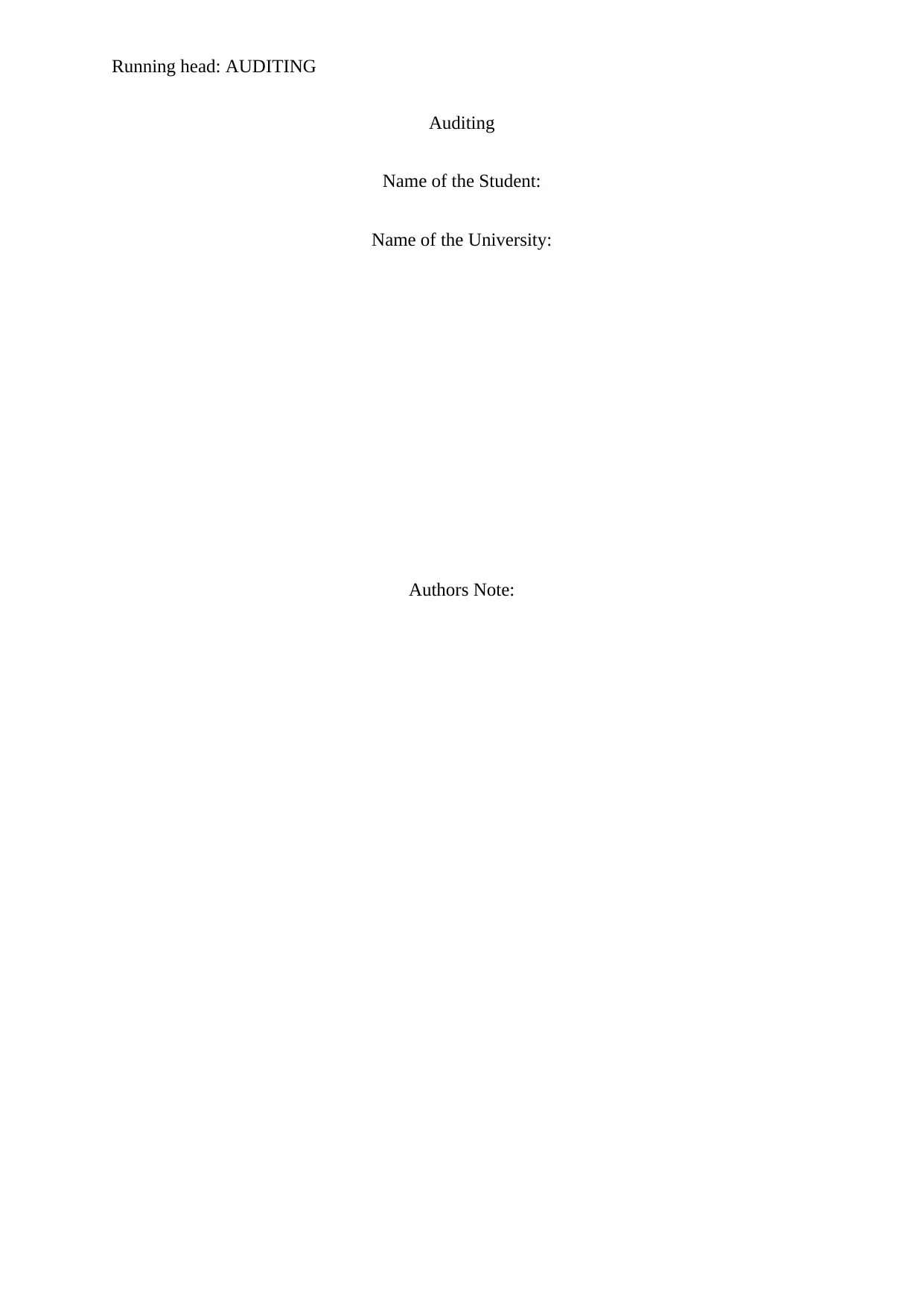
Running head: AUDITING
Auditing
Name of the Student:
Name of the University:
Authors Note:
Auditing
Name of the Student:
Name of the University:
Authors Note:
Paraphrase This Document
Need a fresh take? Get an instant paraphrase of this document with our AI Paraphraser
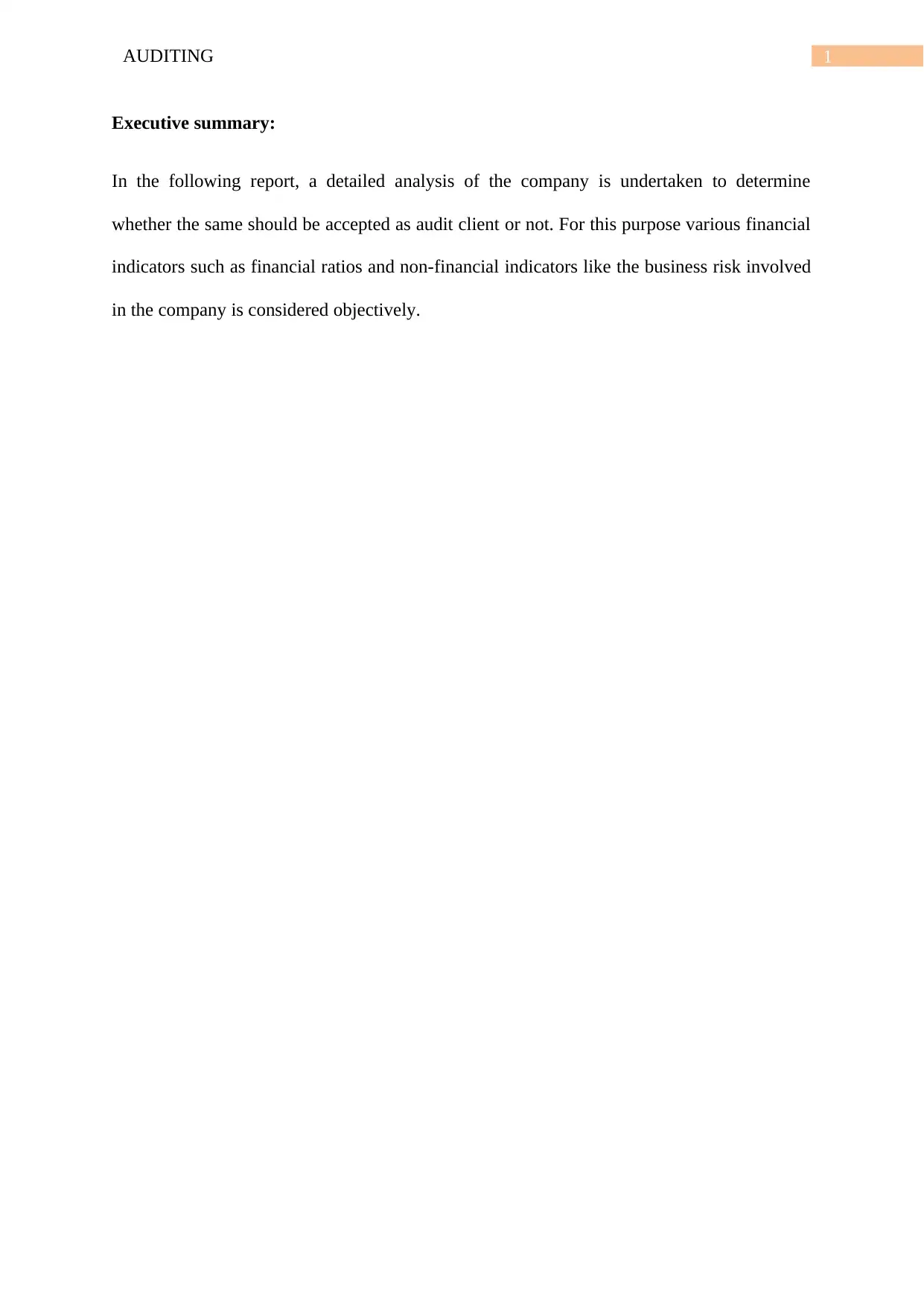
1AUDITING
Executive summary:
In the following report, a detailed analysis of the company is undertaken to determine
whether the same should be accepted as audit client or not. For this purpose various financial
indicators such as financial ratios and non-financial indicators like the business risk involved
in the company is considered objectively.
Executive summary:
In the following report, a detailed analysis of the company is undertaken to determine
whether the same should be accepted as audit client or not. For this purpose various financial
indicators such as financial ratios and non-financial indicators like the business risk involved
in the company is considered objectively.
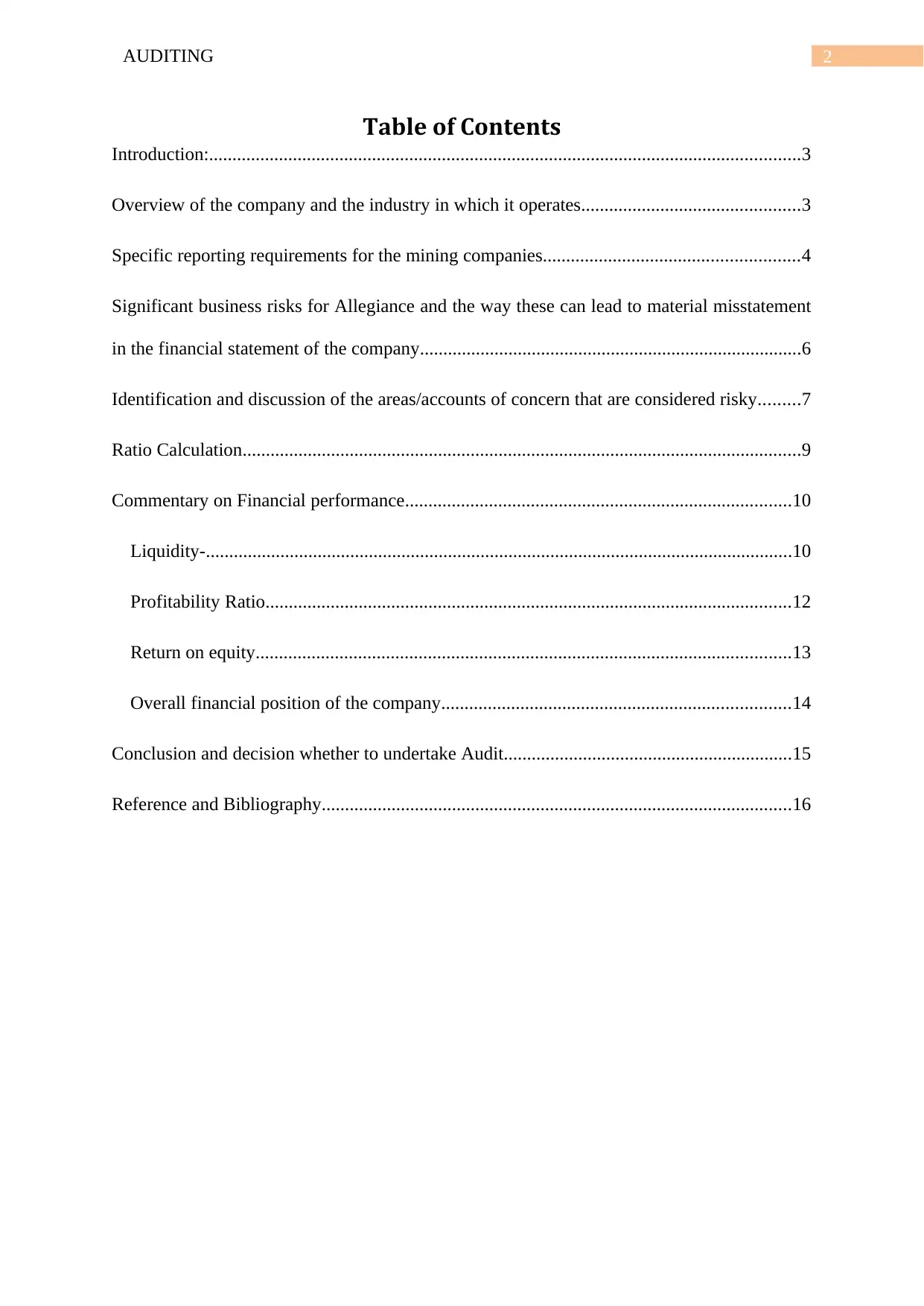
2AUDITING
Table of Contents
Introduction:...............................................................................................................................3
Overview of the company and the industry in which it operates...............................................3
Specific reporting requirements for the mining companies.......................................................4
Significant business risks for Allegiance and the way these can lead to material misstatement
in the financial statement of the company..................................................................................6
Identification and discussion of the areas/accounts of concern that are considered risky.........7
Ratio Calculation........................................................................................................................9
Commentary on Financial performance...................................................................................10
Liquidity-..............................................................................................................................10
Profitability Ratio.................................................................................................................12
Return on equity...................................................................................................................13
Overall financial position of the company...........................................................................14
Conclusion and decision whether to undertake Audit..............................................................15
Reference and Bibliography.....................................................................................................16
Table of Contents
Introduction:...............................................................................................................................3
Overview of the company and the industry in which it operates...............................................3
Specific reporting requirements for the mining companies.......................................................4
Significant business risks for Allegiance and the way these can lead to material misstatement
in the financial statement of the company..................................................................................6
Identification and discussion of the areas/accounts of concern that are considered risky.........7
Ratio Calculation........................................................................................................................9
Commentary on Financial performance...................................................................................10
Liquidity-..............................................................................................................................10
Profitability Ratio.................................................................................................................12
Return on equity...................................................................................................................13
Overall financial position of the company...........................................................................14
Conclusion and decision whether to undertake Audit..............................................................15
Reference and Bibliography.....................................................................................................16
⊘ This is a preview!⊘
Do you want full access?
Subscribe today to unlock all pages.

Trusted by 1+ million students worldwide
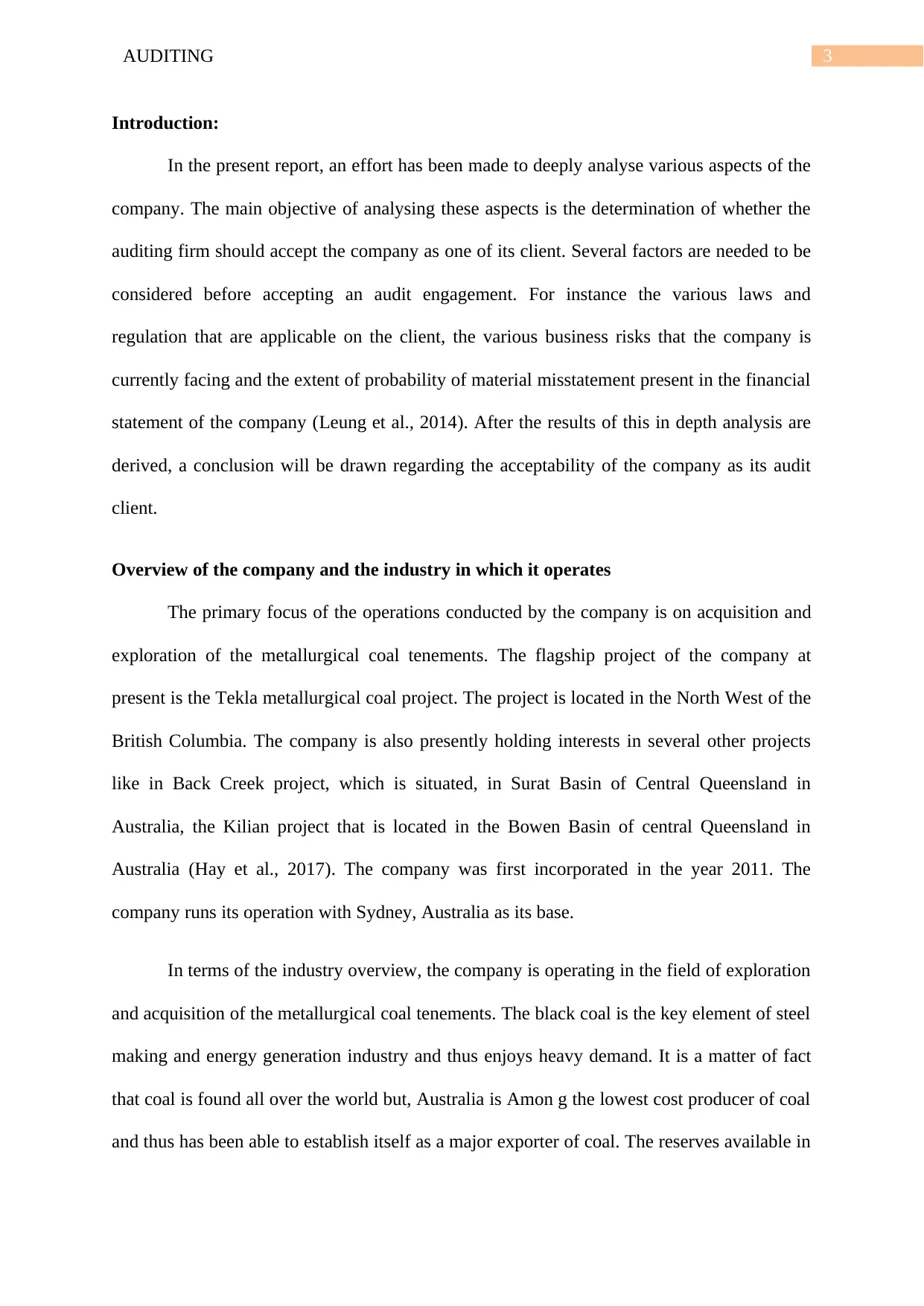
3AUDITING
Introduction:
In the present report, an effort has been made to deeply analyse various aspects of the
company. The main objective of analysing these aspects is the determination of whether the
auditing firm should accept the company as one of its client. Several factors are needed to be
considered before accepting an audit engagement. For instance the various laws and
regulation that are applicable on the client, the various business risks that the company is
currently facing and the extent of probability of material misstatement present in the financial
statement of the company (Leung et al., 2014). After the results of this in depth analysis are
derived, a conclusion will be drawn regarding the acceptability of the company as its audit
client.
Overview of the company and the industry in which it operates
The primary focus of the operations conducted by the company is on acquisition and
exploration of the metallurgical coal tenements. The flagship project of the company at
present is the Tekla metallurgical coal project. The project is located in the North West of the
British Columbia. The company is also presently holding interests in several other projects
like in Back Creek project, which is situated, in Surat Basin of Central Queensland in
Australia, the Kilian project that is located in the Bowen Basin of central Queensland in
Australia (Hay et al., 2017). The company was first incorporated in the year 2011. The
company runs its operation with Sydney, Australia as its base.
In terms of the industry overview, the company is operating in the field of exploration
and acquisition of the metallurgical coal tenements. The black coal is the key element of steel
making and energy generation industry and thus enjoys heavy demand. It is a matter of fact
that coal is found all over the world but, Australia is Amon g the lowest cost producer of coal
and thus has been able to establish itself as a major exporter of coal. The reserves available in
Introduction:
In the present report, an effort has been made to deeply analyse various aspects of the
company. The main objective of analysing these aspects is the determination of whether the
auditing firm should accept the company as one of its client. Several factors are needed to be
considered before accepting an audit engagement. For instance the various laws and
regulation that are applicable on the client, the various business risks that the company is
currently facing and the extent of probability of material misstatement present in the financial
statement of the company (Leung et al., 2014). After the results of this in depth analysis are
derived, a conclusion will be drawn regarding the acceptability of the company as its audit
client.
Overview of the company and the industry in which it operates
The primary focus of the operations conducted by the company is on acquisition and
exploration of the metallurgical coal tenements. The flagship project of the company at
present is the Tekla metallurgical coal project. The project is located in the North West of the
British Columbia. The company is also presently holding interests in several other projects
like in Back Creek project, which is situated, in Surat Basin of Central Queensland in
Australia, the Kilian project that is located in the Bowen Basin of central Queensland in
Australia (Hay et al., 2017). The company was first incorporated in the year 2011. The
company runs its operation with Sydney, Australia as its base.
In terms of the industry overview, the company is operating in the field of exploration
and acquisition of the metallurgical coal tenements. The black coal is the key element of steel
making and energy generation industry and thus enjoys heavy demand. It is a matter of fact
that coal is found all over the world but, Australia is Amon g the lowest cost producer of coal
and thus has been able to establish itself as a major exporter of coal. The reserves available in
Paraphrase This Document
Need a fresh take? Get an instant paraphrase of this document with our AI Paraphraser
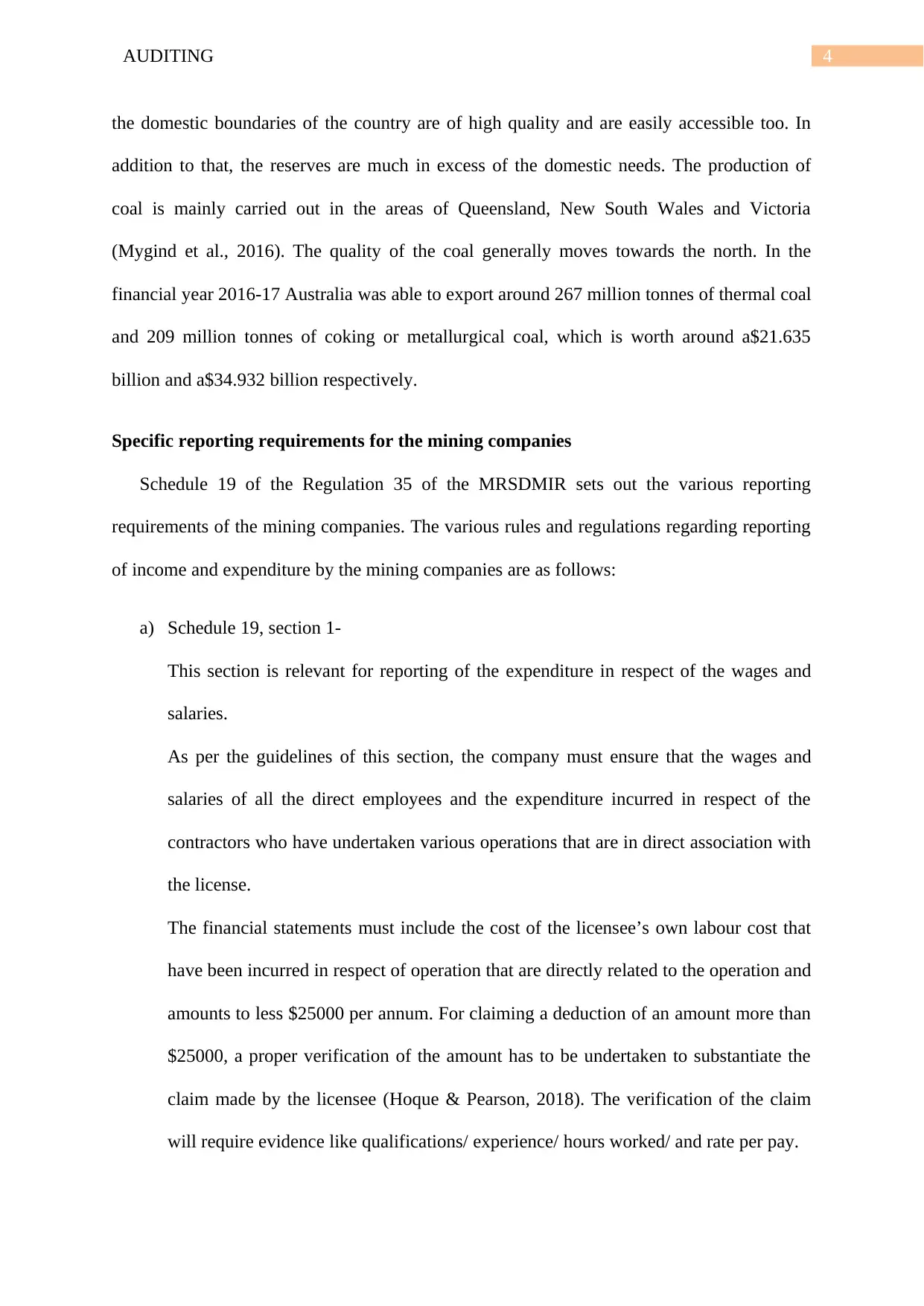
4AUDITING
the domestic boundaries of the country are of high quality and are easily accessible too. In
addition to that, the reserves are much in excess of the domestic needs. The production of
coal is mainly carried out in the areas of Queensland, New South Wales and Victoria
(Mygind et al., 2016). The quality of the coal generally moves towards the north. In the
financial year 2016-17 Australia was able to export around 267 million tonnes of thermal coal
and 209 million tonnes of coking or metallurgical coal, which is worth around a$21.635
billion and a$34.932 billion respectively.
Specific reporting requirements for the mining companies
Schedule 19 of the Regulation 35 of the MRSDMIR sets out the various reporting
requirements of the mining companies. The various rules and regulations regarding reporting
of income and expenditure by the mining companies are as follows:
a) Schedule 19, section 1-
This section is relevant for reporting of the expenditure in respect of the wages and
salaries.
As per the guidelines of this section, the company must ensure that the wages and
salaries of all the direct employees and the expenditure incurred in respect of the
contractors who have undertaken various operations that are in direct association with
the license.
The financial statements must include the cost of the licensee’s own labour cost that
have been incurred in respect of operation that are directly related to the operation and
amounts to less $25000 per annum. For claiming a deduction of an amount more than
$25000, a proper verification of the amount has to be undertaken to substantiate the
claim made by the licensee (Hoque & Pearson, 2018). The verification of the claim
will require evidence like qualifications/ experience/ hours worked/ and rate per pay.
the domestic boundaries of the country are of high quality and are easily accessible too. In
addition to that, the reserves are much in excess of the domestic needs. The production of
coal is mainly carried out in the areas of Queensland, New South Wales and Victoria
(Mygind et al., 2016). The quality of the coal generally moves towards the north. In the
financial year 2016-17 Australia was able to export around 267 million tonnes of thermal coal
and 209 million tonnes of coking or metallurgical coal, which is worth around a$21.635
billion and a$34.932 billion respectively.
Specific reporting requirements for the mining companies
Schedule 19 of the Regulation 35 of the MRSDMIR sets out the various reporting
requirements of the mining companies. The various rules and regulations regarding reporting
of income and expenditure by the mining companies are as follows:
a) Schedule 19, section 1-
This section is relevant for reporting of the expenditure in respect of the wages and
salaries.
As per the guidelines of this section, the company must ensure that the wages and
salaries of all the direct employees and the expenditure incurred in respect of the
contractors who have undertaken various operations that are in direct association with
the license.
The financial statements must include the cost of the licensee’s own labour cost that
have been incurred in respect of operation that are directly related to the operation and
amounts to less $25000 per annum. For claiming a deduction of an amount more than
$25000, a proper verification of the amount has to be undertaken to substantiate the
claim made by the licensee (Hoque & Pearson, 2018). The verification of the claim
will require evidence like qualifications/ experience/ hours worked/ and rate per pay.
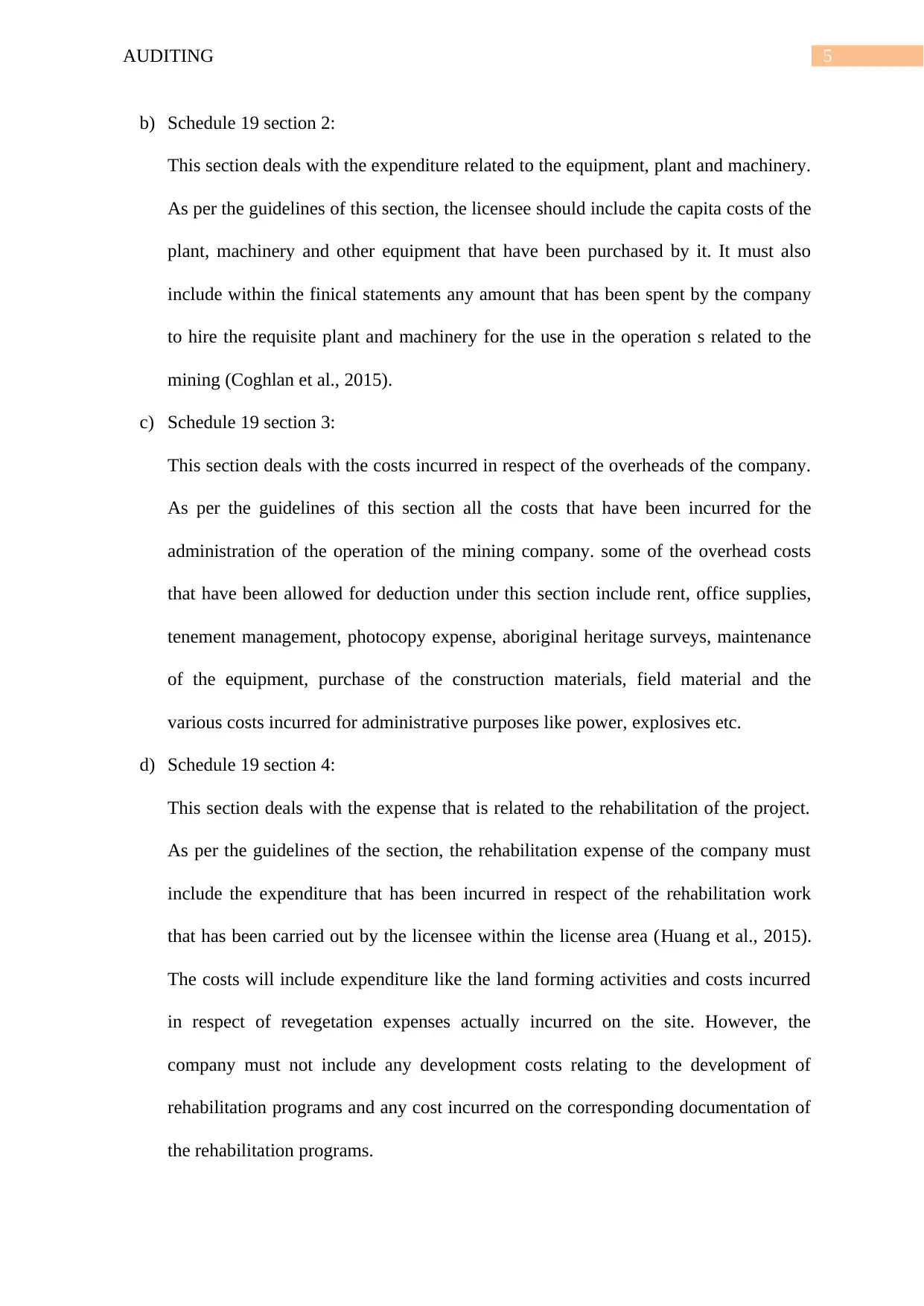
5AUDITING
b) Schedule 19 section 2:
This section deals with the expenditure related to the equipment, plant and machinery.
As per the guidelines of this section, the licensee should include the capita costs of the
plant, machinery and other equipment that have been purchased by it. It must also
include within the finical statements any amount that has been spent by the company
to hire the requisite plant and machinery for the use in the operation s related to the
mining (Coghlan et al., 2015).
c) Schedule 19 section 3:
This section deals with the costs incurred in respect of the overheads of the company.
As per the guidelines of this section all the costs that have been incurred for the
administration of the operation of the mining company. some of the overhead costs
that have been allowed for deduction under this section include rent, office supplies,
tenement management, photocopy expense, aboriginal heritage surveys, maintenance
of the equipment, purchase of the construction materials, field material and the
various costs incurred for administrative purposes like power, explosives etc.
d) Schedule 19 section 4:
This section deals with the expense that is related to the rehabilitation of the project.
As per the guidelines of the section, the rehabilitation expense of the company must
include the expenditure that has been incurred in respect of the rehabilitation work
that has been carried out by the licensee within the license area (Huang et al., 2015).
The costs will include expenditure like the land forming activities and costs incurred
in respect of revegetation expenses actually incurred on the site. However, the
company must not include any development costs relating to the development of
rehabilitation programs and any cost incurred on the corresponding documentation of
the rehabilitation programs.
b) Schedule 19 section 2:
This section deals with the expenditure related to the equipment, plant and machinery.
As per the guidelines of this section, the licensee should include the capita costs of the
plant, machinery and other equipment that have been purchased by it. It must also
include within the finical statements any amount that has been spent by the company
to hire the requisite plant and machinery for the use in the operation s related to the
mining (Coghlan et al., 2015).
c) Schedule 19 section 3:
This section deals with the costs incurred in respect of the overheads of the company.
As per the guidelines of this section all the costs that have been incurred for the
administration of the operation of the mining company. some of the overhead costs
that have been allowed for deduction under this section include rent, office supplies,
tenement management, photocopy expense, aboriginal heritage surveys, maintenance
of the equipment, purchase of the construction materials, field material and the
various costs incurred for administrative purposes like power, explosives etc.
d) Schedule 19 section 4:
This section deals with the expense that is related to the rehabilitation of the project.
As per the guidelines of the section, the rehabilitation expense of the company must
include the expenditure that has been incurred in respect of the rehabilitation work
that has been carried out by the licensee within the license area (Huang et al., 2015).
The costs will include expenditure like the land forming activities and costs incurred
in respect of revegetation expenses actually incurred on the site. However, the
company must not include any development costs relating to the development of
rehabilitation programs and any cost incurred on the corresponding documentation of
the rehabilitation programs.
⊘ This is a preview!⊘
Do you want full access?
Subscribe today to unlock all pages.

Trusted by 1+ million students worldwide
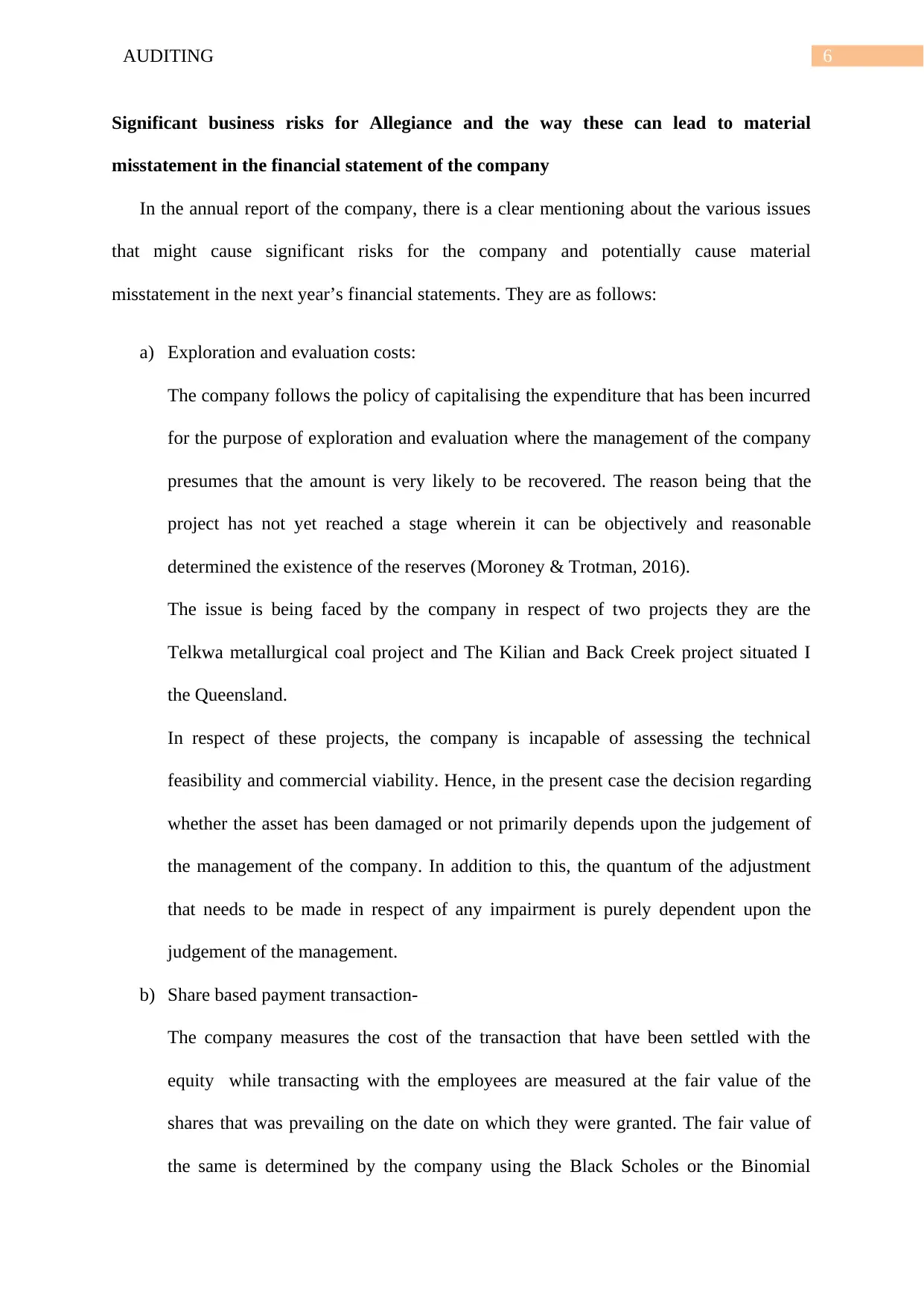
6AUDITING
Significant business risks for Allegiance and the way these can lead to material
misstatement in the financial statement of the company
In the annual report of the company, there is a clear mentioning about the various issues
that might cause significant risks for the company and potentially cause material
misstatement in the next year’s financial statements. They are as follows:
a) Exploration and evaluation costs:
The company follows the policy of capitalising the expenditure that has been incurred
for the purpose of exploration and evaluation where the management of the company
presumes that the amount is very likely to be recovered. The reason being that the
project has not yet reached a stage wherein it can be objectively and reasonable
determined the existence of the reserves (Moroney & Trotman, 2016).
The issue is being faced by the company in respect of two projects they are the
Telkwa metallurgical coal project and The Kilian and Back Creek project situated I
the Queensland.
In respect of these projects, the company is incapable of assessing the technical
feasibility and commercial viability. Hence, in the present case the decision regarding
whether the asset has been damaged or not primarily depends upon the judgement of
the management of the company. In addition to this, the quantum of the adjustment
that needs to be made in respect of any impairment is purely dependent upon the
judgement of the management.
b) Share based payment transaction-
The company measures the cost of the transaction that have been settled with the
equity while transacting with the employees are measured at the fair value of the
shares that was prevailing on the date on which they were granted. The fair value of
the same is determined by the company using the Black Scholes or the Binomial
Significant business risks for Allegiance and the way these can lead to material
misstatement in the financial statement of the company
In the annual report of the company, there is a clear mentioning about the various issues
that might cause significant risks for the company and potentially cause material
misstatement in the next year’s financial statements. They are as follows:
a) Exploration and evaluation costs:
The company follows the policy of capitalising the expenditure that has been incurred
for the purpose of exploration and evaluation where the management of the company
presumes that the amount is very likely to be recovered. The reason being that the
project has not yet reached a stage wherein it can be objectively and reasonable
determined the existence of the reserves (Moroney & Trotman, 2016).
The issue is being faced by the company in respect of two projects they are the
Telkwa metallurgical coal project and The Kilian and Back Creek project situated I
the Queensland.
In respect of these projects, the company is incapable of assessing the technical
feasibility and commercial viability. Hence, in the present case the decision regarding
whether the asset has been damaged or not primarily depends upon the judgement of
the management of the company. In addition to this, the quantum of the adjustment
that needs to be made in respect of any impairment is purely dependent upon the
judgement of the management.
b) Share based payment transaction-
The company measures the cost of the transaction that have been settled with the
equity while transacting with the employees are measured at the fair value of the
shares that was prevailing on the date on which they were granted. The fair value of
the same is determined by the company using the Black Scholes or the Binomial
Paraphrase This Document
Need a fresh take? Get an instant paraphrase of this document with our AI Paraphraser
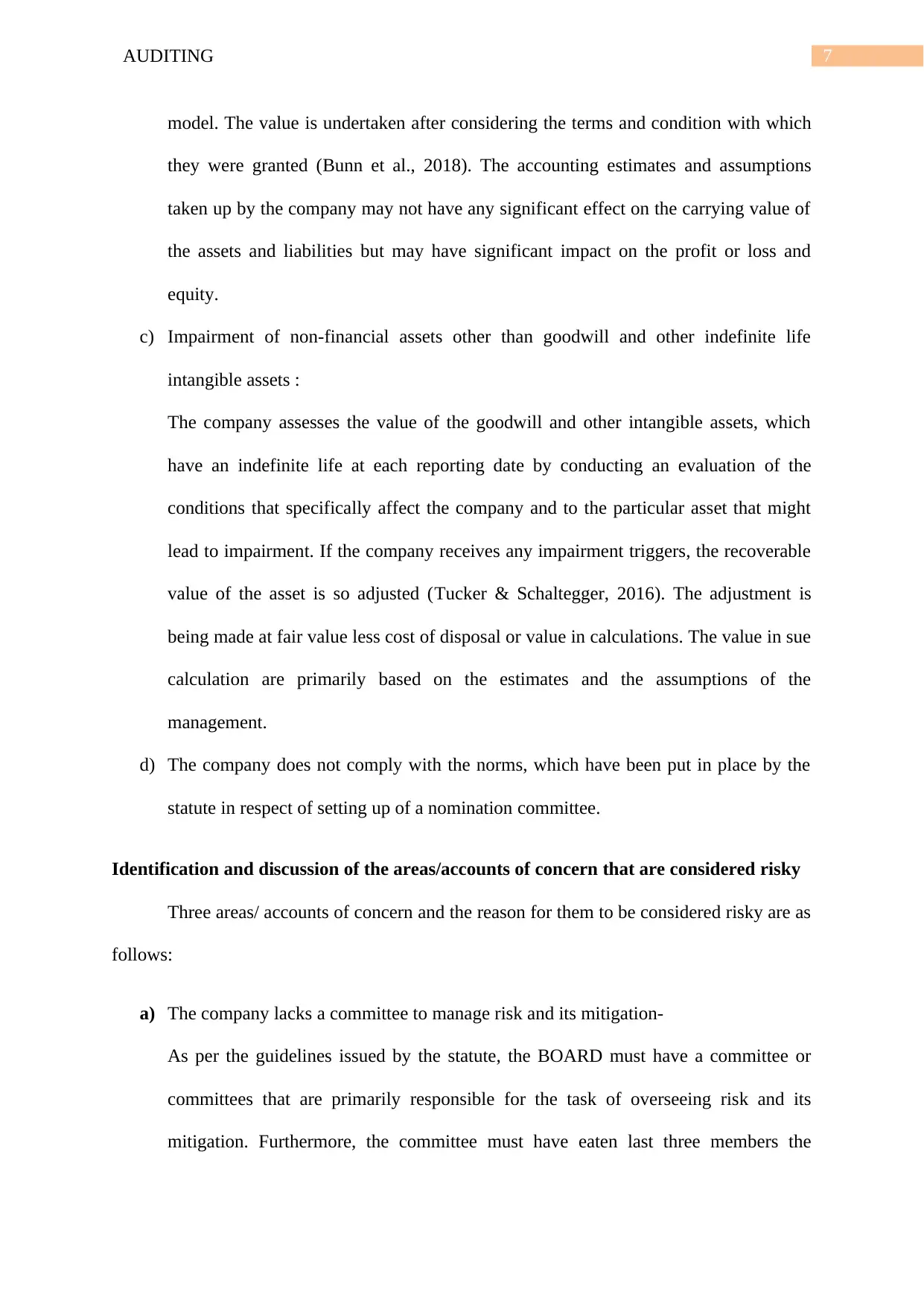
7AUDITING
model. The value is undertaken after considering the terms and condition with which
they were granted (Bunn et al., 2018). The accounting estimates and assumptions
taken up by the company may not have any significant effect on the carrying value of
the assets and liabilities but may have significant impact on the profit or loss and
equity.
c) Impairment of non-financial assets other than goodwill and other indefinite life
intangible assets :
The company assesses the value of the goodwill and other intangible assets, which
have an indefinite life at each reporting date by conducting an evaluation of the
conditions that specifically affect the company and to the particular asset that might
lead to impairment. If the company receives any impairment triggers, the recoverable
value of the asset is so adjusted (Tucker & Schaltegger, 2016). The adjustment is
being made at fair value less cost of disposal or value in calculations. The value in sue
calculation are primarily based on the estimates and the assumptions of the
management.
d) The company does not comply with the norms, which have been put in place by the
statute in respect of setting up of a nomination committee.
Identification and discussion of the areas/accounts of concern that are considered risky
Three areas/ accounts of concern and the reason for them to be considered risky are as
follows:
a) The company lacks a committee to manage risk and its mitigation-
As per the guidelines issued by the statute, the BOARD must have a committee or
committees that are primarily responsible for the task of overseeing risk and its
mitigation. Furthermore, the committee must have eaten last three members the
model. The value is undertaken after considering the terms and condition with which
they were granted (Bunn et al., 2018). The accounting estimates and assumptions
taken up by the company may not have any significant effect on the carrying value of
the assets and liabilities but may have significant impact on the profit or loss and
equity.
c) Impairment of non-financial assets other than goodwill and other indefinite life
intangible assets :
The company assesses the value of the goodwill and other intangible assets, which
have an indefinite life at each reporting date by conducting an evaluation of the
conditions that specifically affect the company and to the particular asset that might
lead to impairment. If the company receives any impairment triggers, the recoverable
value of the asset is so adjusted (Tucker & Schaltegger, 2016). The adjustment is
being made at fair value less cost of disposal or value in calculations. The value in sue
calculation are primarily based on the estimates and the assumptions of the
management.
d) The company does not comply with the norms, which have been put in place by the
statute in respect of setting up of a nomination committee.
Identification and discussion of the areas/accounts of concern that are considered risky
Three areas/ accounts of concern and the reason for them to be considered risky are as
follows:
a) The company lacks a committee to manage risk and its mitigation-
As per the guidelines issued by the statute, the BOARD must have a committee or
committees that are primarily responsible for the task of overseeing risk and its
mitigation. Furthermore, the committee must have eaten last three members the
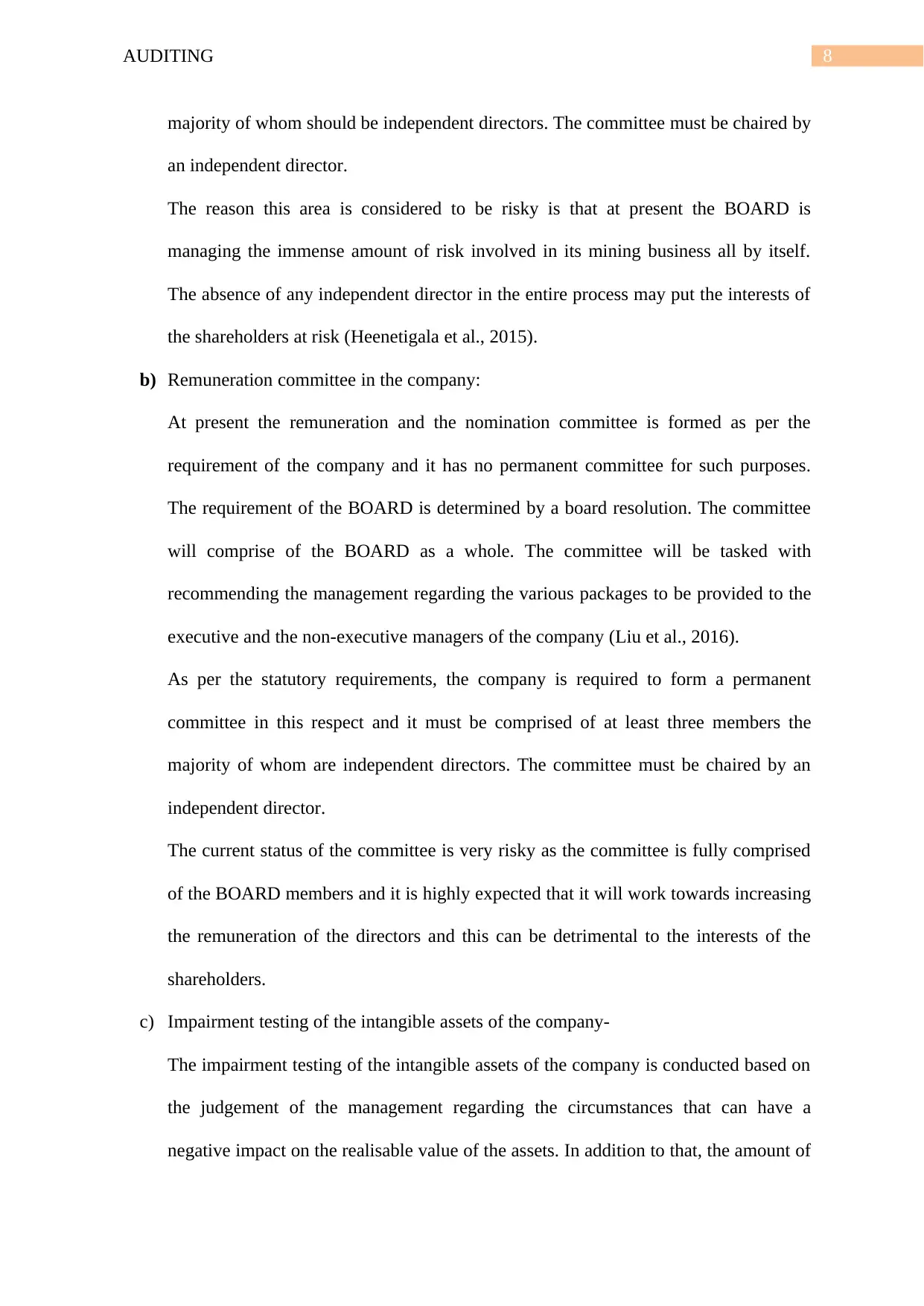
8AUDITING
majority of whom should be independent directors. The committee must be chaired by
an independent director.
The reason this area is considered to be risky is that at present the BOARD is
managing the immense amount of risk involved in its mining business all by itself.
The absence of any independent director in the entire process may put the interests of
the shareholders at risk (Heenetigala et al., 2015).
b) Remuneration committee in the company:
At present the remuneration and the nomination committee is formed as per the
requirement of the company and it has no permanent committee for such purposes.
The requirement of the BOARD is determined by a board resolution. The committee
will comprise of the BOARD as a whole. The committee will be tasked with
recommending the management regarding the various packages to be provided to the
executive and the non-executive managers of the company (Liu et al., 2016).
As per the statutory requirements, the company is required to form a permanent
committee in this respect and it must be comprised of at least three members the
majority of whom are independent directors. The committee must be chaired by an
independent director.
The current status of the committee is very risky as the committee is fully comprised
of the BOARD members and it is highly expected that it will work towards increasing
the remuneration of the directors and this can be detrimental to the interests of the
shareholders.
c) Impairment testing of the intangible assets of the company-
The impairment testing of the intangible assets of the company is conducted based on
the judgement of the management regarding the circumstances that can have a
negative impact on the realisable value of the assets. In addition to that, the amount of
majority of whom should be independent directors. The committee must be chaired by
an independent director.
The reason this area is considered to be risky is that at present the BOARD is
managing the immense amount of risk involved in its mining business all by itself.
The absence of any independent director in the entire process may put the interests of
the shareholders at risk (Heenetigala et al., 2015).
b) Remuneration committee in the company:
At present the remuneration and the nomination committee is formed as per the
requirement of the company and it has no permanent committee for such purposes.
The requirement of the BOARD is determined by a board resolution. The committee
will comprise of the BOARD as a whole. The committee will be tasked with
recommending the management regarding the various packages to be provided to the
executive and the non-executive managers of the company (Liu et al., 2016).
As per the statutory requirements, the company is required to form a permanent
committee in this respect and it must be comprised of at least three members the
majority of whom are independent directors. The committee must be chaired by an
independent director.
The current status of the committee is very risky as the committee is fully comprised
of the BOARD members and it is highly expected that it will work towards increasing
the remuneration of the directors and this can be detrimental to the interests of the
shareholders.
c) Impairment testing of the intangible assets of the company-
The impairment testing of the intangible assets of the company is conducted based on
the judgement of the management regarding the circumstances that can have a
negative impact on the realisable value of the assets. In addition to that, the amount of
⊘ This is a preview!⊘
Do you want full access?
Subscribe today to unlock all pages.

Trusted by 1+ million students worldwide
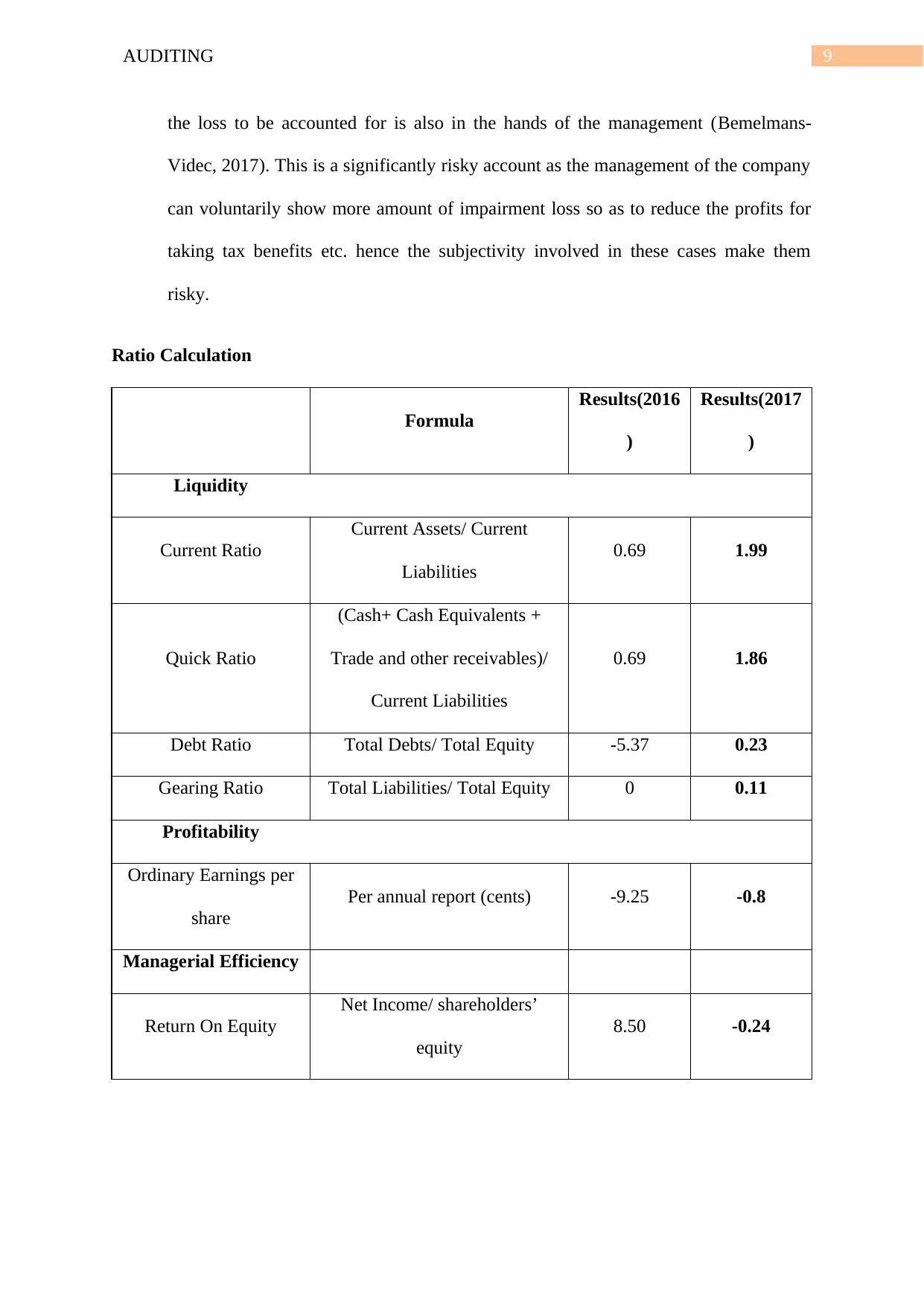
9AUDITING
the loss to be accounted for is also in the hands of the management (Bemelmans-
Videc, 2017). This is a significantly risky account as the management of the company
can voluntarily show more amount of impairment loss so as to reduce the profits for
taking tax benefits etc. hence the subjectivity involved in these cases make them
risky.
Ratio Calculation
Formula
Results(2016
)
Results(2017
)
Liquidity
Current Ratio
Current Assets/ Current
Liabilities
0.69 1.99
Quick Ratio
(Cash+ Cash Equivalents +
Trade and other receivables)/
Current Liabilities
0.69 1.86
Debt Ratio Total Debts/ Total Equity -5.37 0.23
Gearing Ratio Total Liabilities/ Total Equity 0 0.11
Profitability
Ordinary Earnings per
share
Per annual report (cents) -9.25 -0.8
Managerial Efficiency
Return On Equity
Net Income/ shareholders’
equity
8.50 -0.24
the loss to be accounted for is also in the hands of the management (Bemelmans-
Videc, 2017). This is a significantly risky account as the management of the company
can voluntarily show more amount of impairment loss so as to reduce the profits for
taking tax benefits etc. hence the subjectivity involved in these cases make them
risky.
Ratio Calculation
Formula
Results(2016
)
Results(2017
)
Liquidity
Current Ratio
Current Assets/ Current
Liabilities
0.69 1.99
Quick Ratio
(Cash+ Cash Equivalents +
Trade and other receivables)/
Current Liabilities
0.69 1.86
Debt Ratio Total Debts/ Total Equity -5.37 0.23
Gearing Ratio Total Liabilities/ Total Equity 0 0.11
Profitability
Ordinary Earnings per
share
Per annual report (cents) -9.25 -0.8
Managerial Efficiency
Return On Equity
Net Income/ shareholders’
equity
8.50 -0.24
Paraphrase This Document
Need a fresh take? Get an instant paraphrase of this document with our AI Paraphraser
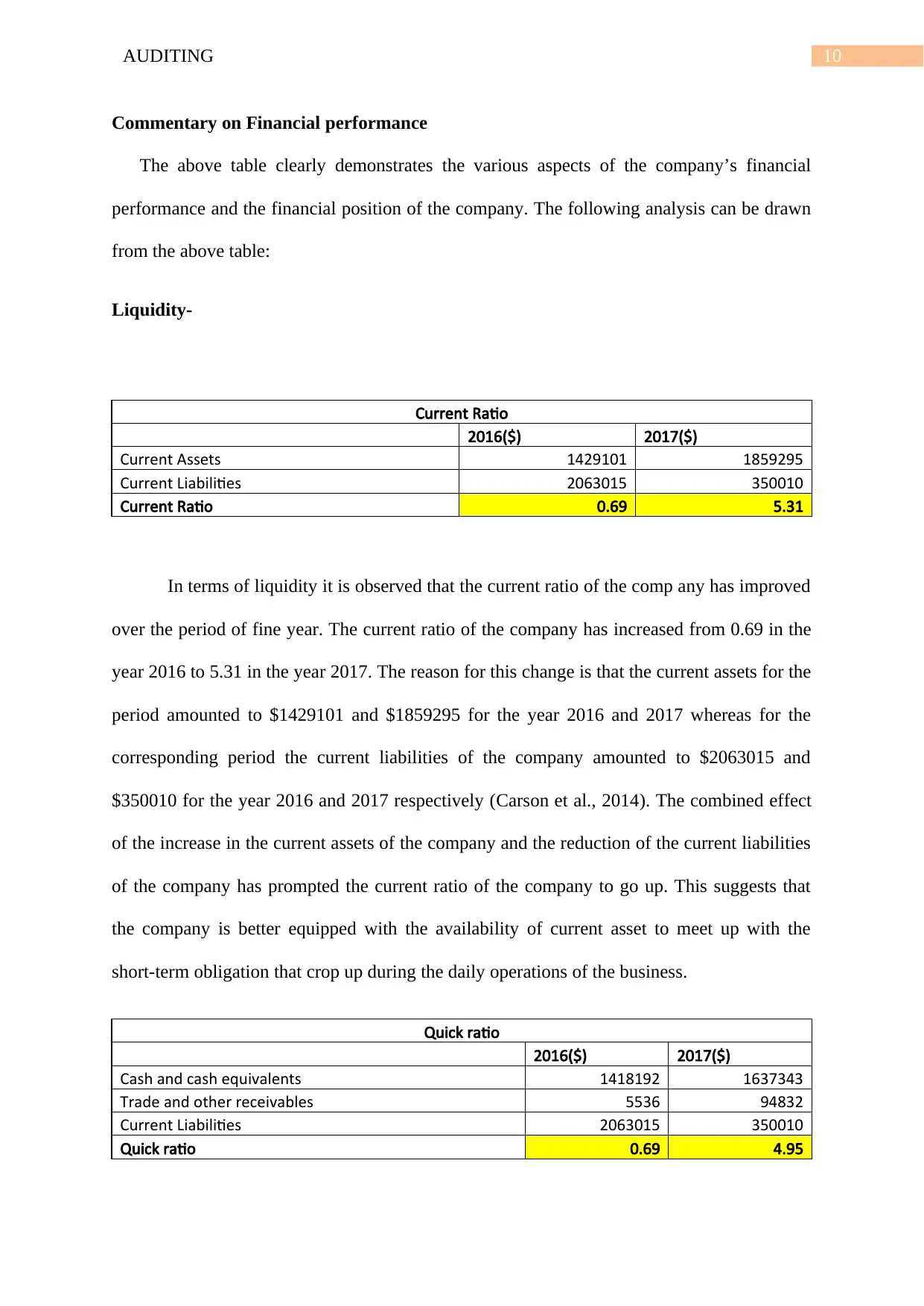
10AUDITING
Commentary on Financial performance
The above table clearly demonstrates the various aspects of the company’s financial
performance and the financial position of the company. The following analysis can be drawn
from the above table:
Liquidity-
Current Ratio
2016($) 2017($)
Current Assets 1429101 1859295
Current Liabilities 2063015 350010
Current Ratio 0.69 5.31
In terms of liquidity it is observed that the current ratio of the comp any has improved
over the period of fine year. The current ratio of the company has increased from 0.69 in the
year 2016 to 5.31 in the year 2017. The reason for this change is that the current assets for the
period amounted to $1429101 and $1859295 for the year 2016 and 2017 whereas for the
corresponding period the current liabilities of the company amounted to $2063015 and
$350010 for the year 2016 and 2017 respectively (Carson et al., 2014). The combined effect
of the increase in the current assets of the company and the reduction of the current liabilities
of the company has prompted the current ratio of the company to go up. This suggests that
the company is better equipped with the availability of current asset to meet up with the
short-term obligation that crop up during the daily operations of the business.
Quick ratio
2016($) 2017($)
Cash and cash equivalents 1418192 1637343
Trade and other receivables 5536 94832
Current Liabilities 2063015 350010
Quick ratio 0.69 4.95
Commentary on Financial performance
The above table clearly demonstrates the various aspects of the company’s financial
performance and the financial position of the company. The following analysis can be drawn
from the above table:
Liquidity-
Current Ratio
2016($) 2017($)
Current Assets 1429101 1859295
Current Liabilities 2063015 350010
Current Ratio 0.69 5.31
In terms of liquidity it is observed that the current ratio of the comp any has improved
over the period of fine year. The current ratio of the company has increased from 0.69 in the
year 2016 to 5.31 in the year 2017. The reason for this change is that the current assets for the
period amounted to $1429101 and $1859295 for the year 2016 and 2017 whereas for the
corresponding period the current liabilities of the company amounted to $2063015 and
$350010 for the year 2016 and 2017 respectively (Carson et al., 2014). The combined effect
of the increase in the current assets of the company and the reduction of the current liabilities
of the company has prompted the current ratio of the company to go up. This suggests that
the company is better equipped with the availability of current asset to meet up with the
short-term obligation that crop up during the daily operations of the business.
Quick ratio
2016($) 2017($)
Cash and cash equivalents 1418192 1637343
Trade and other receivables 5536 94832
Current Liabilities 2063015 350010
Quick ratio 0.69 4.95
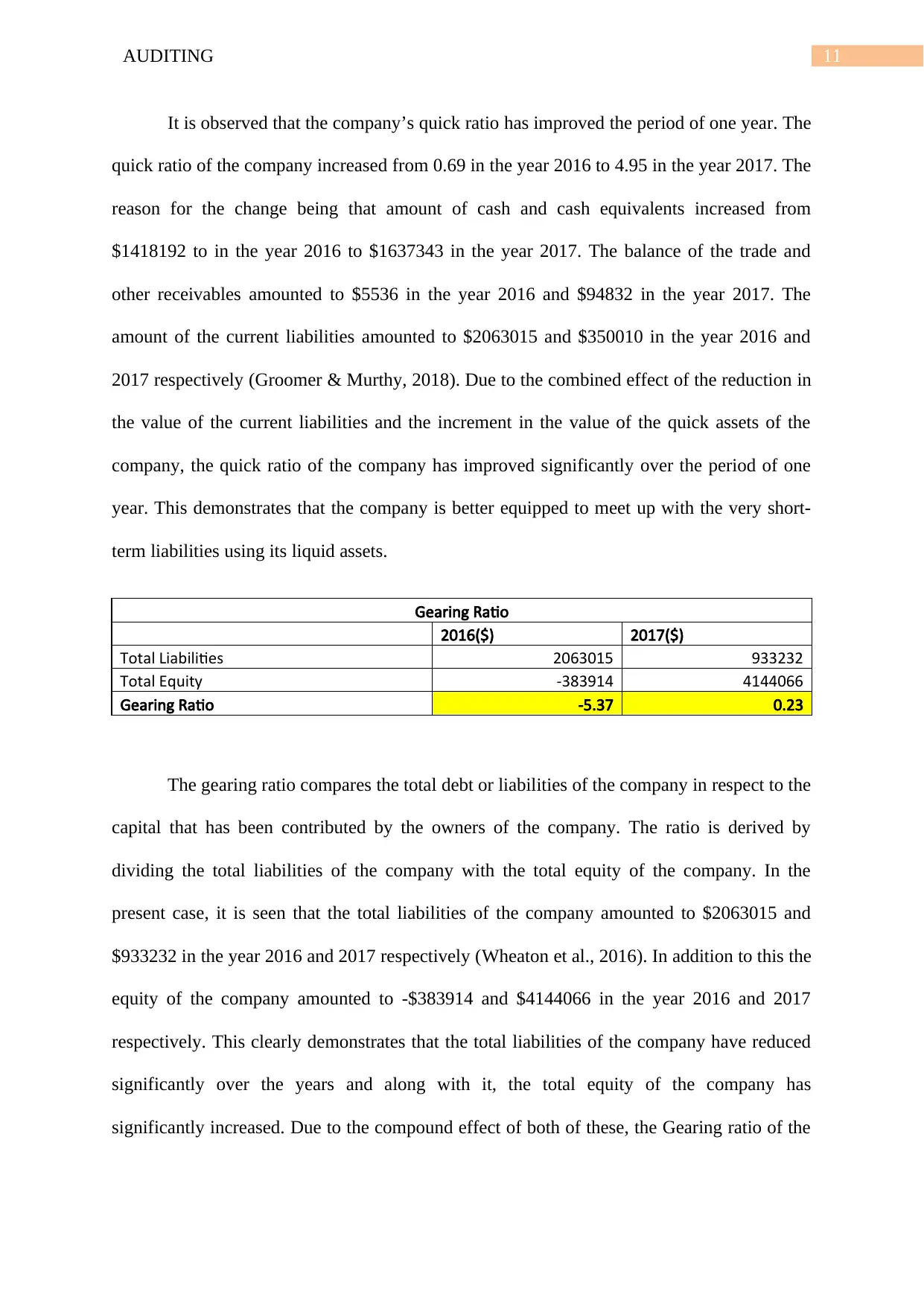
11AUDITING
It is observed that the company’s quick ratio has improved the period of one year. The
quick ratio of the company increased from 0.69 in the year 2016 to 4.95 in the year 2017. The
reason for the change being that amount of cash and cash equivalents increased from
$1418192 to in the year 2016 to $1637343 in the year 2017. The balance of the trade and
other receivables amounted to $5536 in the year 2016 and $94832 in the year 2017. The
amount of the current liabilities amounted to $2063015 and $350010 in the year 2016 and
2017 respectively (Groomer & Murthy, 2018). Due to the combined effect of the reduction in
the value of the current liabilities and the increment in the value of the quick assets of the
company, the quick ratio of the company has improved significantly over the period of one
year. This demonstrates that the company is better equipped to meet up with the very short-
term liabilities using its liquid assets.
Gearing Ratio
2016($) 2017($)
Total Liabilities 2063015 933232
Total Equity -383914 4144066
Gearing Ratio -5.37 0.23
The gearing ratio compares the total debt or liabilities of the company in respect to the
capital that has been contributed by the owners of the company. The ratio is derived by
dividing the total liabilities of the company with the total equity of the company. In the
present case, it is seen that the total liabilities of the company amounted to $2063015 and
$933232 in the year 2016 and 2017 respectively (Wheaton et al., 2016). In addition to this the
equity of the company amounted to -$383914 and $4144066 in the year 2016 and 2017
respectively. This clearly demonstrates that the total liabilities of the company have reduced
significantly over the years and along with it, the total equity of the company has
significantly increased. Due to the compound effect of both of these, the Gearing ratio of the
It is observed that the company’s quick ratio has improved the period of one year. The
quick ratio of the company increased from 0.69 in the year 2016 to 4.95 in the year 2017. The
reason for the change being that amount of cash and cash equivalents increased from
$1418192 to in the year 2016 to $1637343 in the year 2017. The balance of the trade and
other receivables amounted to $5536 in the year 2016 and $94832 in the year 2017. The
amount of the current liabilities amounted to $2063015 and $350010 in the year 2016 and
2017 respectively (Groomer & Murthy, 2018). Due to the combined effect of the reduction in
the value of the current liabilities and the increment in the value of the quick assets of the
company, the quick ratio of the company has improved significantly over the period of one
year. This demonstrates that the company is better equipped to meet up with the very short-
term liabilities using its liquid assets.
Gearing Ratio
2016($) 2017($)
Total Liabilities 2063015 933232
Total Equity -383914 4144066
Gearing Ratio -5.37 0.23
The gearing ratio compares the total debt or liabilities of the company in respect to the
capital that has been contributed by the owners of the company. The ratio is derived by
dividing the total liabilities of the company with the total equity of the company. In the
present case, it is seen that the total liabilities of the company amounted to $2063015 and
$933232 in the year 2016 and 2017 respectively (Wheaton et al., 2016). In addition to this the
equity of the company amounted to -$383914 and $4144066 in the year 2016 and 2017
respectively. This clearly demonstrates that the total liabilities of the company have reduced
significantly over the years and along with it, the total equity of the company has
significantly increased. Due to the compound effect of both of these, the Gearing ratio of the
⊘ This is a preview!⊘
Do you want full access?
Subscribe today to unlock all pages.

Trusted by 1+ million students worldwide
1 out of 19
Related Documents
Your All-in-One AI-Powered Toolkit for Academic Success.
+13062052269
info@desklib.com
Available 24*7 on WhatsApp / Email
![[object Object]](/_next/static/media/star-bottom.7253800d.svg)
Unlock your academic potential
Copyright © 2020–2025 A2Z Services. All Rights Reserved. Developed and managed by ZUCOL.





